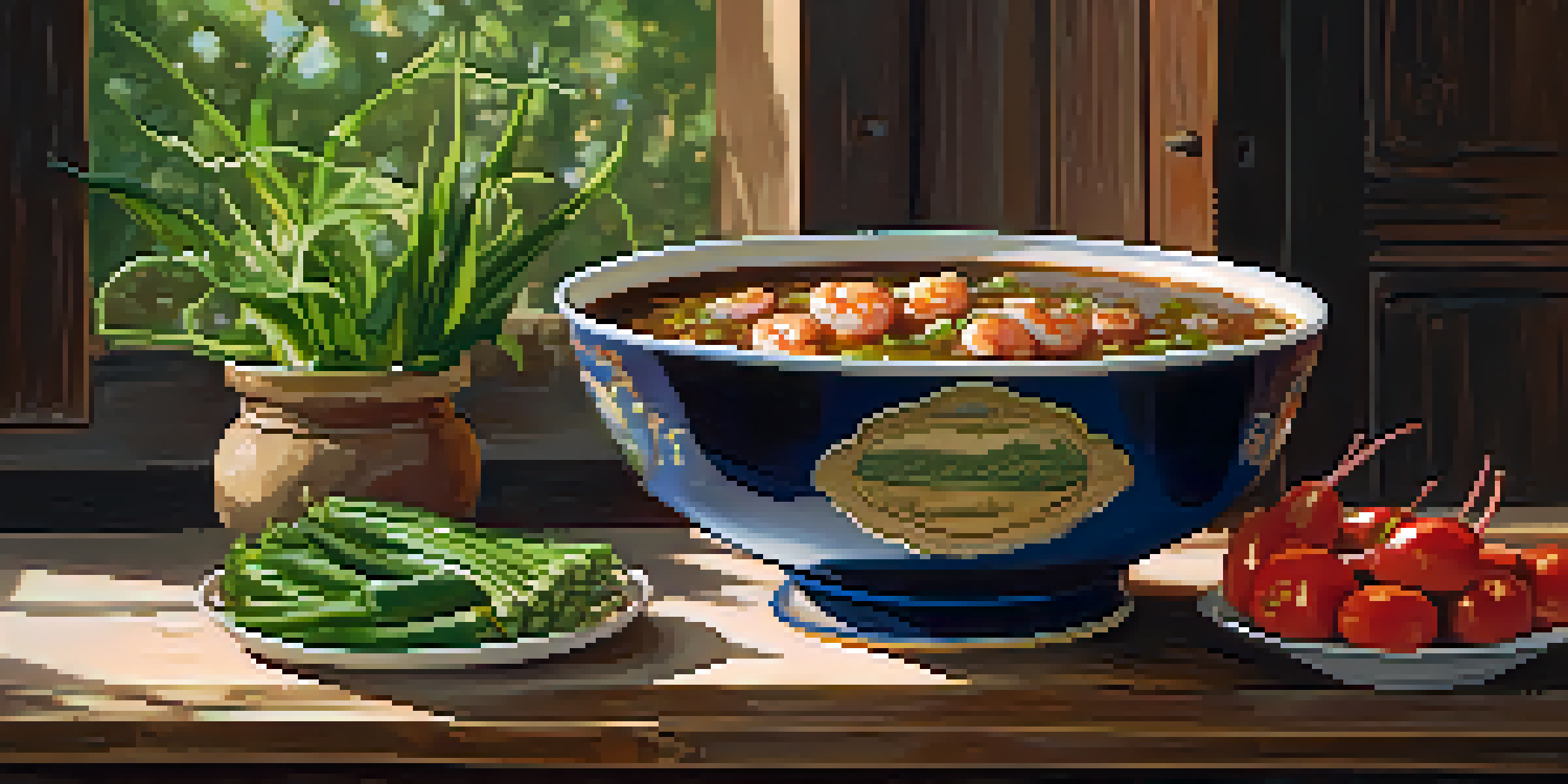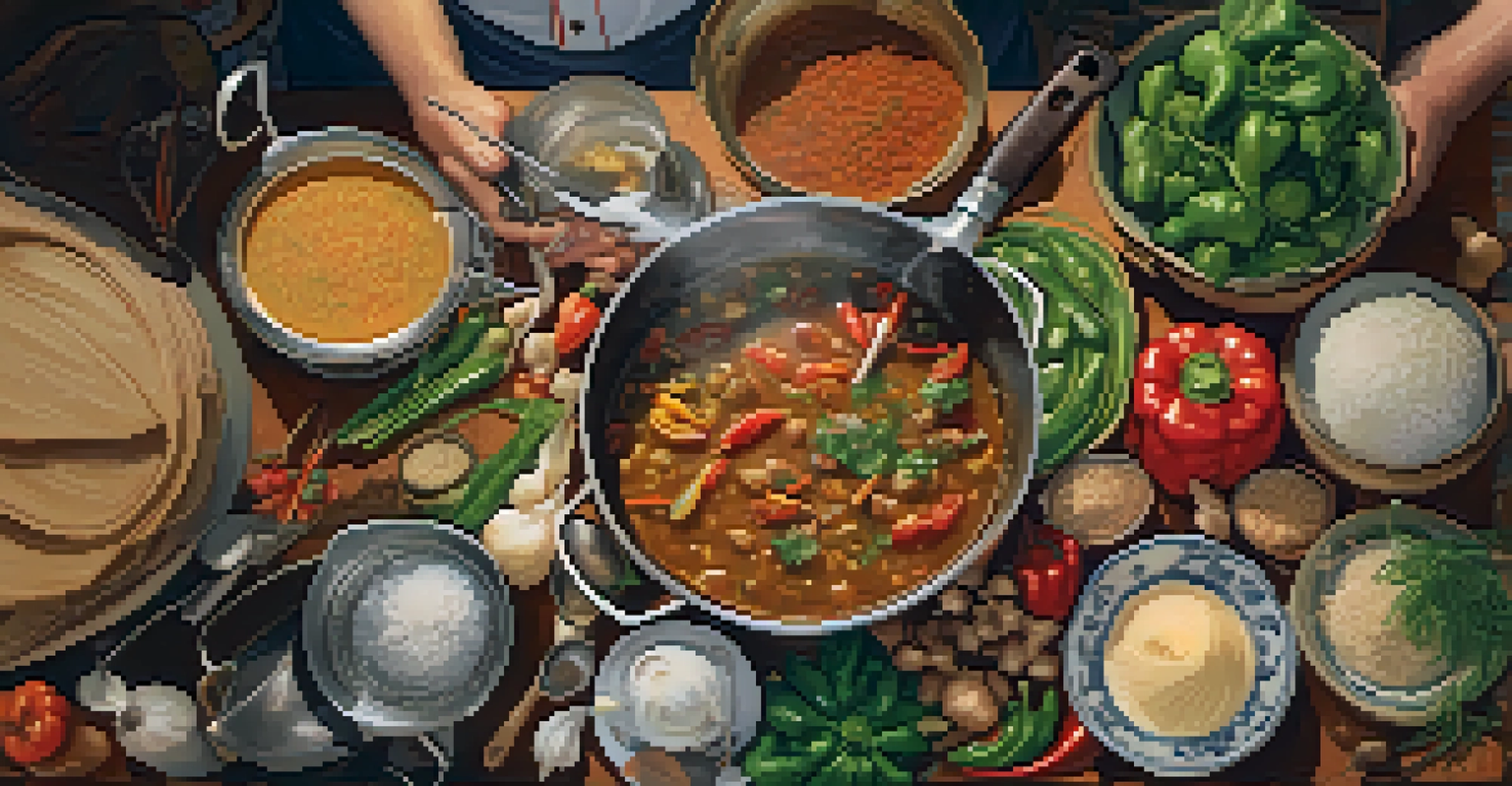Gumbo: The Heart of Louisiana's Culinary Traditions

The Origins of Gumbo: A Cultural Melting Pot
Gumbo is more than just a dish; it's a vibrant symbol of Louisiana's diverse heritage. This beloved stew combines influences from African, French, Spanish, and Native American cuisines, creating a unique culinary tapestry. Each ingredient tells a story, reflecting the state's complex history and the people who have called it home.
Food is a central part of our culture. It’s how we share, how we connect, how we celebrate life’s moments together.
Historically, gumbo emerged in the early 18th century, influenced by the ingredients available in the region. The use of okra, for example, highlights African roots, while the French brought in the concept of a rich roux. This blend of cultures not only shaped the dish but also fostered a sense of community among those who shared it.
Today, gumbo continues to evolve, embracing modern flavors while respecting its traditional roots. Each family has its version, often passed down through generations, making it a personal and cherished recipe. In this way, gumbo serves as a delicious reminder of the cultural exchanges that define Louisiana.
The Key Ingredients: What Makes Gumbo Unique
At the heart of every great gumbo are its key ingredients: a flavorful roux, a mix of proteins, and the 'holy trinity' of vegetables. The roux, made from flour and fat, is cooked until it reaches a rich, deep brown color, providing a robust base for the stew. This essential step is what truly sets gumbo apart from other soups and stews.

The proteins used in gumbo can vary widely, from chicken and sausage to shrimp and crab. This versatility allows cooks to personalize their gumbo, making it a dish that can cater to various tastes and dietary preferences. Similarly, the holy trinity—onion, bell pepper, and celery—adds depth and flavor that is unmistakably Creole.
Gumbo: A Cultural Symbol
Gumbo represents Louisiana's diverse heritage, blending African, French, Spanish, and Native American influences into a beloved dish.
While the classic gumbo features these staple ingredients, chefs often get creative, incorporating local produce and spices. This adaptability not only showcases the bounty of Louisiana’s farms and waters but also makes each pot of gumbo a unique culinary experience. The result is a dish that evolves with the seasons and the chef's imagination.
The Role of Gumbo in Louisiana Culture
In Louisiana, gumbo transcends mere sustenance; it embodies the spirit of community and celebration. Whether served at family gatherings, festivals, or holidays, gumbo brings people together, fostering connections over shared meals. It's common to see large pots simmering at events, inviting everyone to partake in this communal feast.
Cooking is like love. It should be entered into with abandon or not at all.
Culinary traditions in Louisiana are deeply intertwined with cultural events, and gumbo often takes center stage. From Mardi Gras parades to crawfish boils, this dish is a staple that represents the joy and vibrancy of the state's festivities. Each occasion offers an opportunity to celebrate not just the food, but the rich cultural heritage that accompanies it.
Furthermore, gumbo's significance extends beyond its taste; it also serves as a bridge between generations. Elders pass down their recipes and techniques to younger family members, ensuring that the love and tradition behind the dish remain alive. This generational sharing solidifies gumbo's place as a cherished icon of Louisiana's culinary landscape.
Cooking Techniques: Mastering the Art of Gumbo
While gumbo may seem simple, mastering its preparation requires skill and patience. The first step, creating the roux, can be a labor of love, as it involves constant stirring to achieve the perfect color without burning. This crucial step lays the foundation for the depth of flavor that defines an exceptional gumbo.
Once the roux is ready, the next phase involves adding the holy trinity of vegetables, followed by the proteins and broth. Each ingredient should be introduced at the right time to ensure proper cooking and flavor melding. It's a dance of timing and technique that results in a harmonious blend of tastes and textures.
Key Ingredients of Gumbo
The essential components of gumbo—a flavorful roux, proteins, and the 'holy trinity' of vegetables—create a unique and adaptable stew.
Finally, the magic happens when the gumbo simmers, allowing the flavors to develop and meld together. Taste testing along the way is encouraged to adjust seasonings, ensuring the final dish is just right. With practice, anyone can create a gumbo that honors its rich history while delighting the palate.
Gumbo Variations: Exploring Regional Differences
One of the most exciting aspects of gumbo is its regional variations, each reflecting the local culture and available ingredients. For instance, Creole gumbo often features tomatoes, while Cajun gumbo typically omits them, focusing instead on a smoky flavor profile. These distinctions highlight the diverse culinary landscape of Louisiana.
Seafood gumbo is another popular variant, showcasing the state's abundant catch from the Gulf of Mexico. With shrimp, oysters, and crab, this version offers a taste of the ocean and is a favorite among locals and visitors alike. Each spoonful captures the essence of Louisiana's coastal heritage and the flavors of its waters.
Moreover, gumbo can adapt to seasonal ingredients, resulting in unique twists that keep the dish fresh and exciting. Ingredients like andouille sausage, duck, or even wild game may find their way into the pot, allowing every chef to put their personal spin on this cherished dish. This creativity ensures that gumbo remains a beloved staple, forever evolving yet deeply rooted in tradition.
Pairing Gumbo: The Perfect Accompaniments
When it comes to enjoying gumbo, the right accompaniments can elevate the experience. A classic pairing is steamed white rice, which soaks up the rich broth and balances the dish's flavors. This combination not only enhances the meal but also adds a comforting element that is hard to resist.
Another delightful addition is a side of crusty French bread, perfect for dipping into the warm, flavorful stew. The bread serves as a vehicle to savor every drop of gumbo, making it a perfect companion. Some also enjoy a sprinkle of green onions or parsley on top for a fresh, vibrant finish.
Gumbo's Role in Community
In Louisiana, gumbo is more than food; it fosters community and tradition, bringing people together during celebrations and family gatherings.
Finally, don't forget the beverages! A cold beer or a glass of sweet tea complements the spices in gumbo beautifully. Whether you're enjoying a casual family dinner or hosting a festive gathering, these pairings create a well-rounded meal that celebrates the heart and soul of Louisiana's culinary traditions.
Gumbo Today: A Contemporary Culinary Icon
In recent years, gumbo has gained recognition beyond Louisiana, becoming a culinary icon celebrated in many restaurants nationwide. Chefs are now experimenting with fusion styles, incorporating global flavors while maintaining the essence of traditional gumbo. This evolution has sparked a renewed interest in this classic dish, inviting new audiences to appreciate its rich heritage.
Social media has played a role in this gumbo renaissance, with food bloggers and influencers sharing their versions and experiences. Recipes, tips, and personal stories spread like wildfire, inspiring home cooks to try their hand at gumbo-making. This community-driven approach fosters a love for the dish that transcends geographical boundaries.

As gumbo continues to evolve, it remains a testament to the cultural richness of Louisiana. It stands as a symbol of resilience and creativity, reflecting the spirit of the people who create and share it. No matter how it's served, gumbo will always hold a special place in the hearts of those who cherish it.